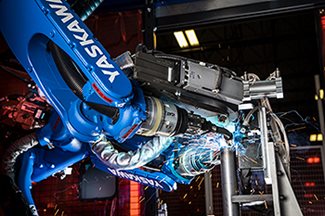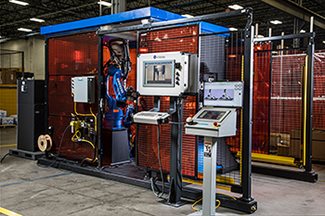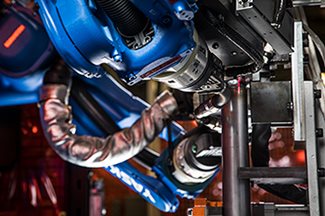 BWI Group (Kettering, Ohio), a premier chassis supplier and manufacturer of vehicle brake and suspension systems, takes safety critical welds to the next level. Founded in 2009 as a joint venture between Shougang Corporation and Beijing Fangshan State & Asset Management Company, Ltd., BWI Group (BWI) manufactures the highest quality products for the global transportation market.
BWI Group (Kettering, Ohio), a premier chassis supplier and manufacturer of vehicle brake and suspension systems, takes safety critical welds to the next level. Founded in 2009 as a joint venture between Shougang Corporation and Beijing Fangshan State & Asset Management Company, Ltd., BWI Group (BWI) manufactures the highest quality products for the global transportation market.
Shortly after the company’s founding, BWI, along with its subsidiaries, acquired the Chassis Division of Delphi Corporation, which was formed years earlier by General Motors Corporation. This depth of experience in the automotive industry, combined with BWI Group’s strong established resources, provides the essential building blocks for producing cutting-edge technology for well-known automotive, motorcycle and specialty vehicle customers around the world.
With a passion for product excellence, BWI Group strives to exceed end user standards, providing the highest level of safety and quality in the industry. While BWI’s Validation and Test Development group performs fatigue or “life” tests on each component during the development process to ensure product safety, speed-to-market is equally vital to company success. For these reasons weld quality and cycle time are key areas of focus on the production floor.
In need of a second opinion about the best equipment combination to use for the incorporation a world-class GMAW weld system that would exceed Original Equipment Manufacturer (OEM) requirements for safety critical welds on thin-wall suspension components, BWI decision makers reached out to industry experts at Miller Electric Mfg. LLC (Appleton, Wisconsin). More specifically, BWI Group wanted Miller Electric’s welding expertise on the ability to assure OEMs that non-conforming parts could be contained from production flow and that safety critical welds were within specified limits.
Solution
 After initial meetings with BWI Group, Miller Electric weld and automation specialists suggested that Yaskawa America Inc. – Motoman Robotics Division (Yaskawa Motoman) be consulted about designing a customized robotic solution.
After initial meetings with BWI Group, Miller Electric weld and automation specialists suggested that Yaskawa America Inc. – Motoman Robotics Division (Yaskawa Motoman) be consulted about designing a customized robotic solution.
Familiar with the ease of use and stellar reputation of Yaskawa Motoman® robots, as well as Yaskawa Motoman’s ability to provide regional support around the world, BWI’s engineering team agreed to observe a joint demonstration by the Yaskawa Motoman and Miller Electric team at Yaskawa Motoman headquarters in Miamisburg, Ohio.
Several weeks before the presentation date, BWI Group supplied the welding brackets and tube assemblies to be welded to the Yaskawa Motoman location. Here, a joint team of automation engineers and welding experts, from both Yaskawa Motoman and Miller Electric, integrated technology and developed procedures for BWI’s challenging application.
Fixturing to prevent components from being loaded incorrectly was designed and built on site, and an expert from Hobart Filler Metals (Troy, Ohio) was also consulted to discuss alternative wire types. It was determined that the best wire for the weld process was ER70S0-3 .035 (90/10 gas) solid wire, a general purpose welding wire for the fabrication of mild steel.
Upon the completion of research and development, the welding demonstration at Yaskawa Motoman headquarters took place. Impressed with the customer service and automation capabilities of Yaskawa Motoman, combined with their strong working relationship with Miller Electric, BWI solidified the decision to move forward with the customization of four ArcWorld® 1200 workcells to fulfill immediate applications needs at its production facility in Chihuahua, Mexico.
Laser Seam Inspection System
 Each customized system featured two Motoman MH12 six-axis robots configured for arc welding to support the weight of a Vitronic laser seam inspection system to monitor weld size, porosity, undercut, crater fill and more. Likewise, every welding robot included a Miller Auto-Continuum™ 500 weld package and a Miller Coolmate™ 4 water circulator.
Each customized system featured two Motoman MH12 six-axis robots configured for arc welding to support the weight of a Vitronic laser seam inspection system to monitor weld size, porosity, undercut, crater fill and more. Likewise, every welding robot included a Miller Auto-Continuum™ 500 weld package and a Miller Coolmate™ 4 water circulator.
To enable each MH12 robot with the ability to verify that short structural welds were performed within established limits, Miller Electric’s advanced Insight Centerpoint™ arc data monitoring software was configured to monitor amperage and voltage and integrated with the Vitronic laser seam inspection system. This configuration facilitated the robotic welding system to track non-conforming parts unloaded by the operator. An HMI operator station with pedestal mount provided the graphic display workcell operators needed to monitor the weld sequence and clamp status for each weldment.
Application demands also required each cell to utilize: one Binzel TCS-Reamer, one MSR-355 rotary positioner, one hard-stop kit, and two MHT-185 headstock/tailstock positioners, featuring the patented MotoMount™ fixture mounting system to simplify tooling and reduce stress on positioner bearings. Yaskawa’s MotoCal™ software tool was integrated on each robot as well to improve absolute positioning accuracy, Tool Control Point (TCP) and tool posture.
Results
By the summer of 2018, BWI Group implemented consistent use of the ArcWorld workcells to robotically weld a variety of suspension components, supplying high-end struts and shocks to multiple vehicle manufacturers in the United States and abroad. Since this full implementation of customized workcells at its production facility in Chihuahua, Mexico, the cycle time with welding, inspection and positioner rotation for various parts has significantly improved.
Each two-station system operates three shifts, five days a week to maintain a regular production schedule. While the contribution of seam tracking technology adds to the cycle time of each part, the implementation of more efficient robotic workcells capable of producing high-quality welds, has eliminated costly rework, improving the overall cycle time and optimizing productivity.
The prior robot programming knowledge possessed by BWI team members has greatly contributed to a smooth transition during the implementation process, facilitating quick utilization of each workcell. The flexibility for changeover provided by each welding system, combined with the advanced software and innovative technology used, has delivered transformative results. Excellent quality welds are meeting high-end customer demands and exceeding OEM requirements for safety critical welds in the process.
Full case study article originally published in The Fabricator®.